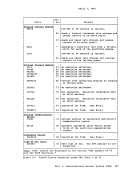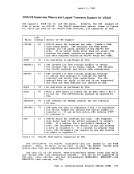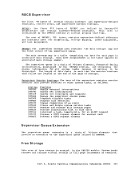In attached processor systeas, all real I/O operations and associated
interrupts are handledby the aain processor. Virtual I/O initiated on
the attached processor that isaapped to real devices must transfer
control to themain processor for real I/O execution. Therefore,
benefitsmay be realized in a virtual aachine "mix" by relegating those
virtual machines that have a high I/O-to-compute ratio to themain processor, and those virtual machines that have a high compute-to-I/O ratio to the attached processor. Such decisions should be carefully
weiahed as everv virtualmachine is in contention with othp.r virtnal machines-for ----- -------
Amore important use of the affinity setting would be in applications
where there are virtual machine program requirements for special
hardware features that are available on one processor and not the other.Such features could be a performance enhancement such as virtual machine
assist (described later in the text) or a specialRPQ that is a
requirement for a particular program's execution.VIRTUAL MACHINE ASSIST FEATURE The virtual machine assist feature is a processor hardware feature that
improves the performance ofVM/370. Virtual storage operating systems. which run in problem state under the control of VM/310, use many privileged instructions and SVCs that cause interrupts that V!/310 aust handle. When the virtual machine assist feature is used. many of these
interrupts are intercepted and handledby the processor. Consequently. VM/310 performance is improved.
TheVirtual Machine Assist Feature intercepts and handles
interruptions causedby SVCs (other than SVC 16), invalid page
conditions, and several privileged instructions. AnSVC 16 is never
handledby the assist feature; it is always handled by CP. The
processing of the following privileged instructions is handledby this
feature:
LRASTCTL RRB ISK SSK IPK STNSM STOSM SSM LPSW SPKA (load real address)
(store control)
(reset reference bit)
(insert storage key)
(set storage key)
(insertPSW key)
(store then AND system mask)
(store thenOR system mask) (set systea mask) (load PSW) (set PSW key froa address)
Although the assist feature was designed to improve the performance
ofVM/370, virtual machines may see a performance improvement because aore resources are available for virtual machine users. For a list of
processors on which theVirtual Machine Assist Feature is available, see
theIBM 1M/370 System Programmer:s Guide
interrupts are handled
the attached processor that is
control to the
benefits
virtual machines that have a high I/O-to-compute ratio to the
weiahed as everv virtual
A
where there are virtual machine program requirements for special
hardware features that are available on one processor and not the other.
assist (described later in the text) or a special
requirement for a particular program's execution.
improves the performance of
interrupts are intercepted and handled
The
interruptions caused
conditions, and several privileged instructions. An
handled
processing of the following privileged instructions is handled
feature:
LRA
(store control)
(reset reference bit)
(insert storage key)
(set storage key)
(insert
(store then AND system mask)
(store then
Although the assist feature was designed to improve the performance
of
processors on which the
the















































































































































































































































































































































































































































